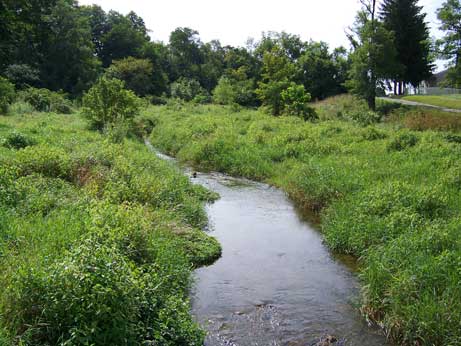 What: A riparian buffer is a vegetated area that runs along a stream, lake, pond, or reservoir. This area is left undisturbed or un-mowed and may consist of grasses, shrubs, or trees. A buffer is considered a “forested” buffer when the permanent vegetation is predominantly native trees and shrubs and has at least 60% uniform canopy cover.
What: A riparian buffer is a vegetated area that runs along a stream, lake, pond, or reservoir. This area is left undisturbed or un-mowed and may consist of grasses, shrubs, or trees. A buffer is considered a “forested” buffer when the permanent vegetation is predominantly native trees and shrubs and has at least 60% uniform canopy cover.
Why: A riparian buffer reduces water pollution by intercepting and filtering runoff from adjacent urban, industrial, or agricultural land, it slows stream water velocities to reduce flood events. The vegetation roots of a buffer protects vulnerable soils along the streambank and prevents erosion. Blair County has approximately 6,500 miles of stream running through our urban, rural and mountainous landscapes. Riparian buffers are crucial to the protection and enhancement of the water resources in Blair County and across Pennsylvania.
How: A three-zone buffer is the best model for protecting and restoring a riparian buffer, however, only planting Zone-1 provides great benefits.
Zone 1
Zone 1 is the portion of the buffer closest to the stream and extends upland from the water’s edge at least 35 feet. A 35-foot buffer will provide a root system from the trees and shrubs to reduce soil erosion, stabilize the stream bank, and keep sediment, excess nutrients, and pollution out of the water. This area should be planted with native trees and shrubs that tolerate wet conditions. The trees and shrubs provide habitat and food source for fish and other wildlife.
Zone 2
Zone 2 is adjacent to Zone-1 and is typically a more managed forest area. The recommended width of this Zone can vary depending on the size of the stream and the desired benefits. The vegetation here slows runoff from upland areas, absorbs excess nutrients preventing them from entering the water, and helps slow runoff allowing it to recharge the groundwater supply. It also provides food and shelter for many wildlife species. Varied native trees and shrubs could be planted here, but this area invites an opportunity to be creative and plant species that can generate economic benefits. This area can grow fruit, nuts, mushrooms, woodland herbs, and berries.
Zone 3
Zone 3 of the buffer is a great place to grow native grasses and/or broad-leaved herbaceous plants and wildflowers. This Zone is another area that could control runoff. Dense grasses evenly spread surface water flow and absorb nutrients to minimize flooding, filtering, and recharging groundwater. This is a great pollinator habitat too. This Zone could also grow plants for economic value such as berries, herbs, or cut flowers.
To learn more about buffers, contact The Blair County Conservation District. District staff can help provide technical services. The District is also offering grants up to $15,000 to Blair County landowners interested in establishing riparian buffers. As described above, riparian buffers can be a combination of grasses, plants, trees, and shrubs which are planted as permanent vegetation along a stream, river, pond or lake. Grant awards will follow the District’s Wetland Mitigation Account Policy with each site evaluated on the District’s Riparian Buffer Program Application Procedures and Evaluation.
For more information, we have provided resources through the attached quick links. Should you have any questions related to buffers or for specific information regarding the District’s Riparian Buffer Program contact the District’s Watershed Specialist.
https://www.dcnr.pa.gov/Conservation/Water/RiparianBuffers/Pages/default.aspx

